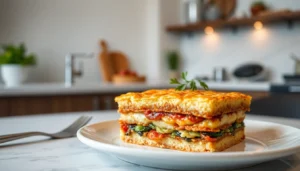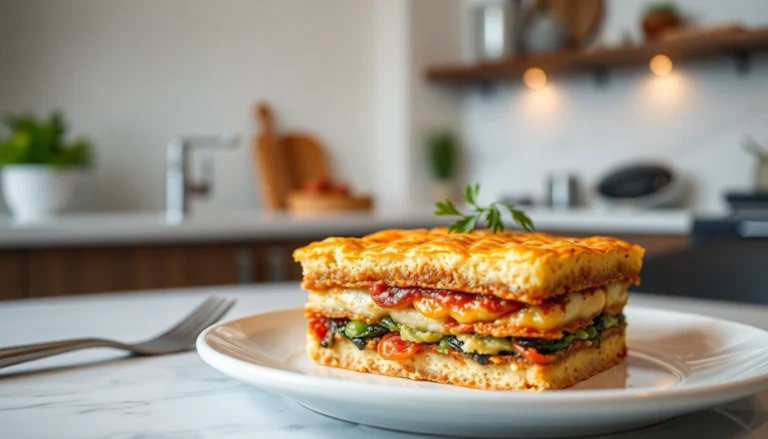Understanding the Concept of Small Size Strata
Definition and Origin of Strata in Culinary Arts
The term small size strata in culinary context refers to a miniaturized, personalized version of the classic layered casserole dish known simply as strata. Originating from American cuisine, strata is a savory baked dish that combines bread, eggs, cheese, and various fillings, creating a hearty, comfort-food breakfast or brunch option. The word “strata” is derived from Latin, meaning “layers,” which perfectly describes its structure. The dish’s roots trace back to the early 20th century, with its modern incarnation developing as a practical, make-ahead breakfast casserole that caters to both family gatherings and elegant brunches.
Strata’s culinary evolution embraced versatility—culinary inventors have tailored it with diverse ingredients, accommodating dietary preferences and ingredient availability. The advent of small size strata variants highlights a growing trend towards individual servings, offering convenience, portion control, and aesthetic appeal, which appeal particularly in modern social settings and cafes.
Benefits of Making Small Size Strata for Breakfast and Brunch
Creating small size strata offers a spectrum of benefits that cater to both hosts and diners. First, portion control is significantly enhanced, minimizing food waste and aligning with health-conscious eating habits. For instance, individual servings are ideal for guests with dietary restrictions or preferences, enabling customization—vegetarian, gluten-free, and vegan options are easily incorporated.
Additionally, personalized small strata facilitate stress-free preparation and presentation: individual mini casseroles can be baked simultaneously, served elegantly, and replenished effortlessly—perfect for breakfast buffets or brunch parties. They also excel in meal prepping and reheating—many recipes are designed to be made in advance, frozen, and quickly reheated, saving busy mornings.
From an operational perspective, small strata recipes promote efficiency—baking times and techniques are consistent, and serving is simplified since each guest receives their own portion. This approach enhances guest experience by offering visually appealing, perfectly heated, and ready-to-eat servings.
Key Ingredients and Preparation Techniques
Choosing the Right Bread, Cheese, and Fillings
The foundation of any great small size strata is quality ingredients. For the bread, opt for sturdy options like baguette, challah, brioche, or day-old rustic bread—these absorb custard well without becoming overly soggy. The choice of cheese can dramatically influence flavor—popular selections include sharp cheddar, Gruyère, Swiss, or a blend of cheeses for enhanced complexity.
Fillings are highly versatile. Common options include cooked breakfast meats such as bacon, sausage, or ham, as well as vegetables like spinach, bell peppers, mushrooms, or tomatoes. To add nutritional value, consider incorporating protein-rich ingredients such as tofu or cottage cheese for vegetarian or vegan variants. Balance is key; use enough fillings to provide flavor and moisture but avoid overstuffing, which can compromise baking uniformity.
For best results, pre-cook or sauté fillings to reduce excess moisture and ensure even cooking in the oven. Fresh herbs, spices, and seasonings should be introduced thoughtfully to elevate the flavor profile without overpowering the dish.
Step-by-Step Guide to Assembling a Small Size Strata
- Prepare the Base: Cube the selected bread and evenly distribute it in individual ramekins or mini baking dishes.
- Add Fillings: Distribute prepared fillings over the bread. For layered effect, add some fillings between bread layers.
- Mix Custard: Whisk eggs, milk (or cream), salt, pepper, and optional herbs. For flavor variations, add grated cheese into the custard.
- Pour Custard: Carefully pour the custard mixture over each prepared serving, ensuring bread and fillings are saturated.
- Refrigerate: Cover and chill in the refrigerator for at least 30 minutes, preferably overnight, to allow flavors to meld and the bread to soak thoroughly.
- Bake: Bake in a preheated oven at 350°F (175°C) for approximately 20-25 minutes or until puffed, golden, and a toothpick inserted in the center comes out clean.
Using individual ramekins or mini muffin tins ensures uniform baking and attractive presentation. For a decorative touch, garnish with fresh herbs or a sprinkle of cheese before serving.
Tips for Achieving Perfect Texture and Flavor
- Use Stale Bread: Slightly stale bread absorbs custard better, resulting in a moist yet firm texture.
- Custard Ratio: Maintain the ideal ratio of eggs to milk—generally 1:1—for a creamy consistency.
- Layer Thoughtfully: Place fillings strategically to maximize flavor distribution and visual appeal.
- Pre-soak: Allow the assembled strata to sit refrigerated for at least 30 minutes or overnight for deeper flavor and even moisture absorption.
- Bake Carefully: Avoid overbaking, which can make the texture rubbery; check for doneness with a toothpick or thermometer.
- Flavor Enhancements: Add spices like nutmeg, cayenne, or a splash of hot sauce to the custard for added depth.
Properly balanced ingredients and patience during soaking are key to mastering small size strata with exemplary taste and texture.
Cooking Tips for Small Size Strata Success
Optimal Soaking and Refrigeration Times
The soaking period is crucial—allowing the bread to absorb the custard ensures moistness and cohesive texture. Ideally, assemble your small size strata the night before baking, refrigerating it for at least 8 hours. This extended soaking time allows the flavors to develop fully and ensures that each bite delivers the harmonious combination of custard, cheese, and fillings.
If time-constrained, a minimum of 30 minutes of refrigeration is acceptable, but flavor penetration and texture will be less optimal. For larger batches or layered dishes, consider the thickness of fillings and adjust soaking times accordingly.
Cooking Temperature and Time for Even Baking
Maintain a steady temperature of 350°F (175°C) for consistent cooking, ensuring the custard sets evenly without burning the surface. For individual mini servings, bake for 20–25 minutes; for larger or thicker servings, extend baking time by 5-10 minutes.
To verify doneness, insert a toothpick into the center; it should come out clean or with moist crumbs. Allow resting for 5 minutes before serving to let the strata stabilize and enhance flavor infusion.
Creative Presentation Ideas for Personal Servings
Presentation elevates the dining experience. Serve small strata in individual ramekins, mini cast iron pans, or even cupcake liners for a casual yet polished look. Garnish with microgreens, chopped herbs, or a drizzle of balsamic reduction for color contrast and added flavor. For buffets, arrange on tiered platters with decorative labels or skewer mini servings for easy grab-and-go style.
Using transparent dishes highlights the colorful ingredients and layered structure, enticing guests visually and appetizingly.
Adapting Recipes for Dietary Preferences
Vegetarian and Vegan Variations of Small Strata
To cater to vegetarian or vegan diets, substitute animal-based ingredients with plant-based alternatives. Use plant-based cheeses, such as vegan cheddar or cashew cheese, and incorporate hearty vegetables like mushrooms, zucchini, and kale. For protein, add legumes, tofu, or tempeh. Instead of eggs, commercial egg replacers or blends of silken tofu mixed with dairy-free milk can be used—ensuring similar binding and texture.
Consider using coconut milk or almond milk in the custard for vegan options, and flavor with nutritional yeast, smoked paprika, or turmeric to mimic savory depths.
Adding Protein: Bacon, Sausage, or Tofu
Incorporating protein enriches small strata, making it more filling. For meat options, pre-cook bacon, sausage, or ham until browned to reduce grease. For plant-based proteins, sautéed tofu crumbles or tempeh add savory elements. Distribute evenly in the layers to ensure every serving has a balanced protein element. Proper pre-cooking prevents excess moisture and maintains texture.
Gluten-Free and Low-Calorie Options
Gluten-free adaptations involve using bread made from almond flour, rice cakes, or gluten-free bread slices. To lower calorie content, reduce cheese quantity or use lighter dairy options. Incorporate more vegetables, lean proteins, or mushrooms to boost flavor with fewer calories. Always ensure fillings and custard components are aligned with dietary goals.
Serving and Storing Small Size Strata
Best Ways to Serve Fresh or Reheat Easily
For serving fresh small strata, garnish with herbs or fresh salsa for vibrancy. To reheat, place in a preheated oven at 350°F (175°C) for 10–15 minutes or until heated through. Microwaves are an option for quick reheating; cover the individual portions with a damp paper towel to prevent drying out. For best textures, avoid over-reheating, which can cause dryness or rubberiness.
Storage Tips for Make-Ahead Breakfasts
After baking, allow strata to cool completely before refrigerating. Store in airtight containers for up to 3 days. For longer storage, freeze individual portions wrapped tightly in foil or plastic wrap, then thaw overnight in the fridge before reheating. Labelfreeze packages with date to maintain freshness.
Proper storage preserves taste and texture, turning make-ahead meals into reliable options for busy mornings or meal planning.
Ideas for Complementary Sides and Beverages
Pair small strata with fresh fruit salads, mixed greens, or toasted artisan bread. Light beverages such as freshly brewed coffee, herbal teas, or fresh juice complement the richness of the dish. For more indulgent brunches, prosecco or a mimosa can add a celebratory touch.
Presentation matters—consider plating with colorful garnishes or serving on rustic platters to enhance visual appeal.







